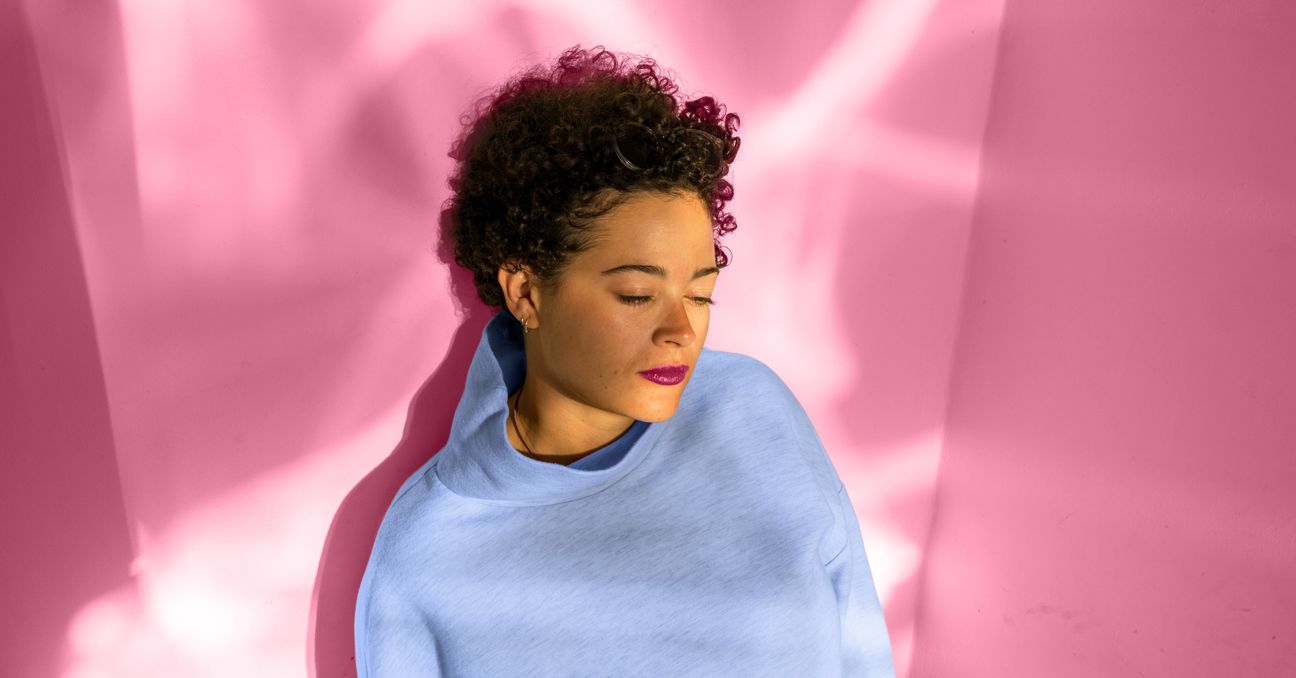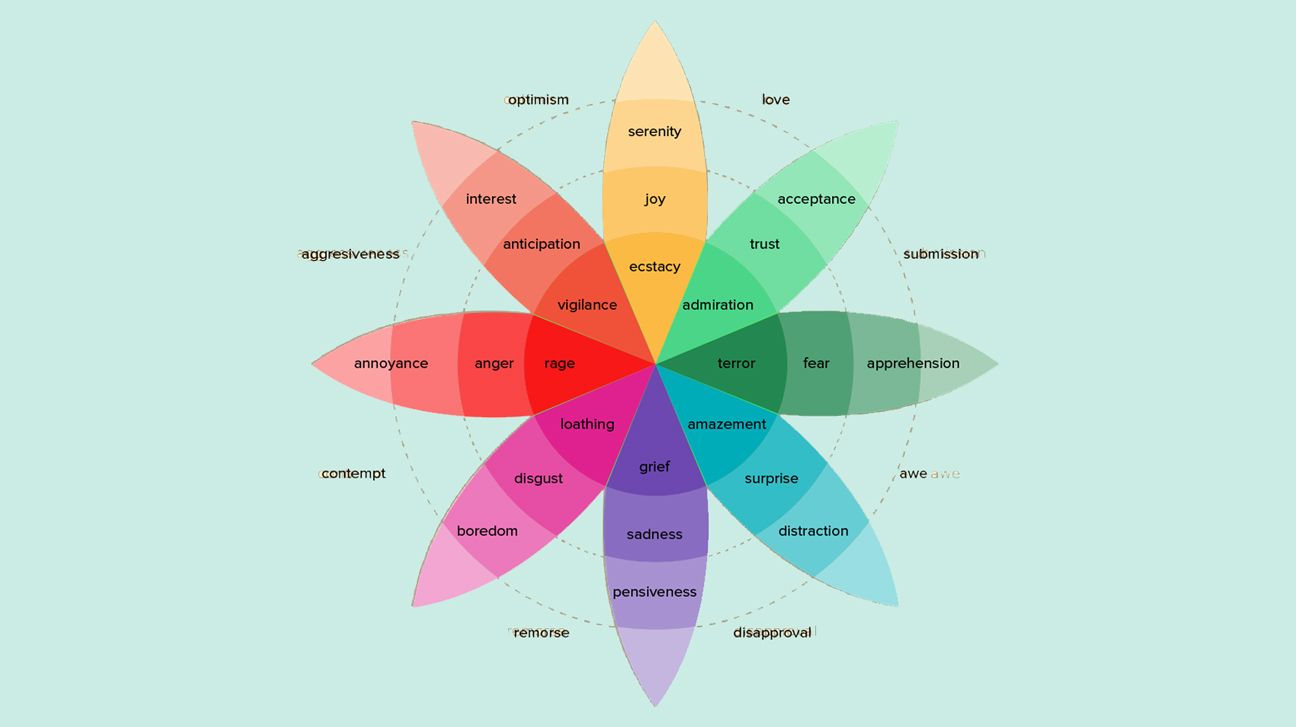You know those days when you just feel… off? Without thinking, you’re brusque with your roommate, so they’re defensive back and before you know it, the whole house is buzzing with bad vibes.
We have a saying for these seemingly inexplicable bad moods: waking up on the wrong side of the bed. As if the bad mood fairy came by and sprinkled vexation dust on us the night before.

But bucketing all of our foul moods into a vague category of “feeling off” doesn’t give us much insight into our inner selves. And part of emotional intelligence is the ability to recognize and understand different emotions when they pop up. Once we do that, we can start to manage how we react.
Emotional wheels are a tool that can help you do just that. And while these pretty creations aren’t like popping a pill, they can be used to gather more information about ourselves. Here are the most popular ones and how to use to them.

| Design | a colorful eight-point flower placed within a larger octagon — initial emotions sit closer to the center, with related/subsequent emotions moving in stages down each petal |
|---|---|
| Creator | renowned American psychologist Robert Plutchik |
| Primary emotions | joy and sadness, fear and anger, anticipation and surprise, trust and disgust |
| Where to see the wheel | https://commons.wikimedia.org/wiki/File:Plutchik-wheel.svg |
Created in 1980, Robert Plutchik’s flower-shaped diagram remains one of the most popular emotional wheels. He believed emotions served an evolutionary purpose, theorizing that each primary emotion triggers us to act or behave in a way that furthers our survival.
Benefits of the Plutchik wheel
- It shows how two emotions combine to create a third (e.g. joy + trust = love).
- Each opposing emotional pair is attached to an opposing pair of physical reactions. For example, joy and sadness translates to making connections vs. withdrawing, while fear and anger translates to keeping quiet/hiding vs. standing up/getting louder.
- Every emotion has an intensity scale, which outlines the importance of recognizing and dealing with the initial feeling.
| Design | a large wheel shape, with three inner circles — broader emotional groups are in the center, and emotions become more specific as they move toward the edge |
|---|---|
| Who created it | members of The Junto Institute, a professional development company |
| Primary emotions | love, fear, anger, sadness, surprise, joy |
| Where to find it | https://www.thejuntoinstitute.com/blog/the-junto-emotion-wheel-why-and-how-we-use-it |
The Junto wheel wasn’t designed based off formal research, but a mishmash of other existing wheels. It was created as a for-profit tool to help companies function better by strengthening the emotional intelligence of their employees.
Benefits of the Junto wheel
- Unlike other wheels, “love” is a primary emotion, separate from happiness. It’s refreshing to try to decipher the subtle differences in not only negative emotions but positive ones too.
- It’s also super comprehensive. It contains 108 different emotions!
| Design | a square, divided into quadrants — an XY axis charts Unpleasantness/Pleasantness and High/Low Control |
|---|---|
| Who created it | academics at the University of Geneva |
| Primary emotions | none (20 different emotions are given equal weighting) |
| Where to find it | https://www.researchgate.net/figure/Prototype-version-Version-10-of-the-GEW-with-16-emotion-terms-Baenziger-et-al-2005_fig1_280880848 |
Designed by academics, whose primary objective was to create “positive consumer experiences,” the wheel was used in a study as way to gather empirical data on people’s emotions.
Benefits of the Geneva wheel
- It reveals that some emotions are more controllable than others. For example, you have a very little control over feeling surprised or sad, but you can control your anger (even if it feels like you can’t).
- Gives the option of feeling “no emotions” or “other emotions,” which can be validating for people who experience emotional numbness.
| Design | a large wheel with three circles contained within — primary emotions sit at the core, with secondary and tertiary feelings moving out closer to the edge |
|---|---|
| Who created it | Geoffrey Roberts, an Australian pastor (based on a design by Gloria Willcox) |
| Primary emotions | surprised, bad, fearful, angry, disgusted, sad, happy |
| Where to find it | http://feelingswheel.com/ |
According to Roberts, he created the feelings wheel to help people identify their emotions, in order to better manage their reactions. This wheel wasn’t designed through formal research but has been a big hit on social media.
Benefits of the Feelings Wheel
- This wheel is super comprehensive, with 130 total emotions listed.
- Designed with more of a focus on negative emotions, it provides more scope to recognize and work through them.
Being in touch with your emotions isn’t just some free spirit, 70s-style way of thinking: being able to name negative emotions has been shown to de-escalate their intensity. It’s more or less a way to check yourself before you wreck yourself. And, thanks to the enhanced communication skills that will also arise, you’ll likely find that relationships with partners, friends, family, and colleagues benefit.
There’s no one “right” way to read an emotional wheel and, like we said, it can’t be used as a treatment. Think of it as a tool for more self-knowledge. Here’s what it can help you do.
Label your emotions
Let’s go back to your off day. Are you feeling frustration? Anxiety about letting someone down? By looking at a wheel, you’re essentially given a list of emotions to choose from. Once you’ve put a name to what you’re feeling, you’re on your way to the important part: management.
Manage your reactions
With greater clarity around what you’re really feeling, you’ll be better equipped to react in a more reasonable manner. And based on a 2010 study, this might change your life. They found that the better people could regulate their emotions, the happier and more financially successful they were.
It’s worth remembering that the charts can also help understand happy emotions, too. Received an unexpected gift from a friend? Look past the basic emotion of joy and see what else you might be feeling: valued, loving, and thankful are all states worth relishing as well.
Communicate what you’re feeling
It’s going to be very hard to convey to another person what’s going on inside that head of yours if you don’t understand it yourself. So you’re miserable. That’s a start but it’s too broad to help someone else understand what exactly happened.
Are you miserable because you’re annoyed/frustrated/resentful? These details are extremely important in opening up honest, productive dialogue. It’s definitely not easy and you might stumble over your words, but taking a look at an emotional wheel could provide you with the language you need.
And, if you’re walking around with a big grin on your face, share the joy! Research shows that conveying good news with another can not only bolster your mood further, but also help build trust.
As useful as you might find an emotional wheel when it comes to unpacking your own thoughts and feelings, don’t be tempted to start using it to psychoanalyze those around you. It goes without saying that emotions are a highly personal state of affairs, and what someone seems to be feeling on the surface could be very different inside.
It’s also important to remember that they may not resonate with you at all. Our feelings are often a tangled web (hence why many of us spend so much $$$ on therapy), and if a colorful diagram isn’t enough to help you sort yours out, don’t sweat it.
We all have different levels of emotional awareness and intelligence, and if you were brought up in a situation in which keeping quiet about emotions was encouraged, then the prospect of vocalizing them will be especially daunting.
So go at your own pace, do what feels right, and be gentle — the wheels will be waiting for you.
Chantelle Pattemore is a writer and editor based in London, UK. She focuses on lifestyle, health, beauty, food, and fitness.

